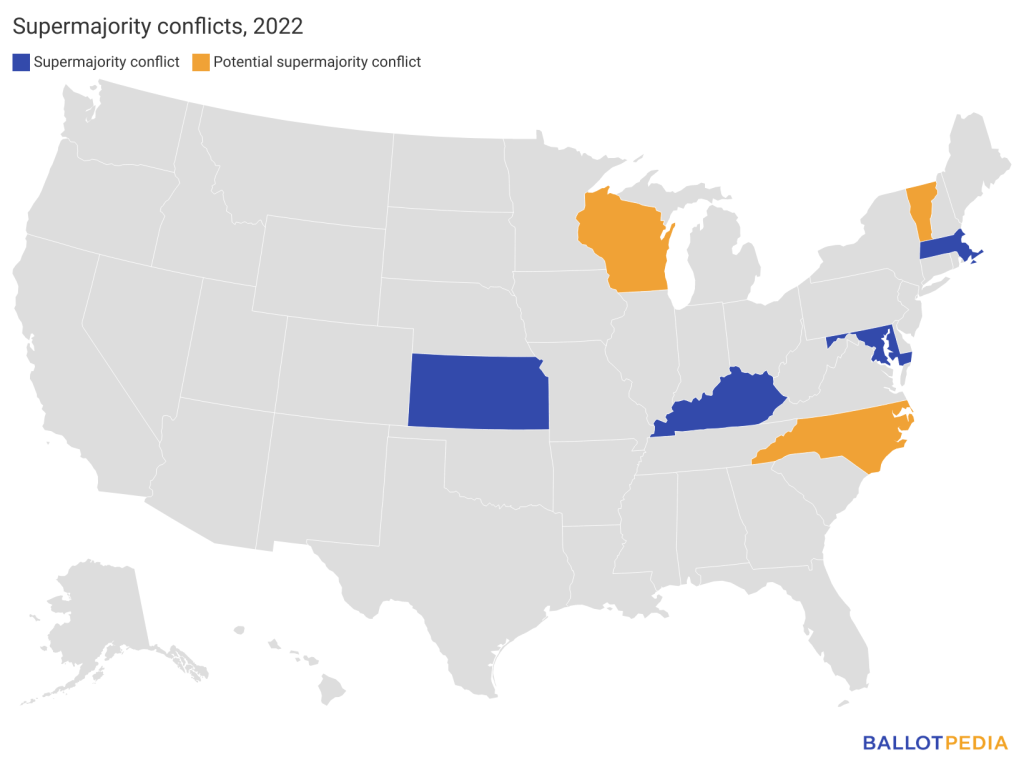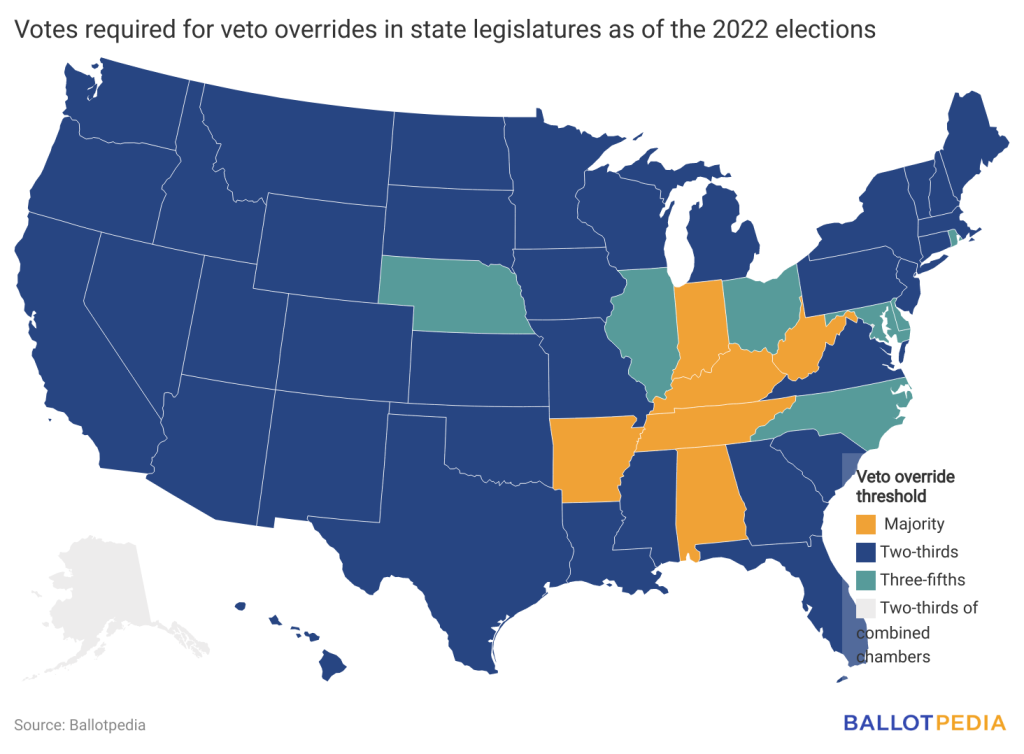Four states have a governor of one party and veto-proof legislative majorities of the opposing party: Kansas, Kentucky, Maryland, and Massachusetts. Voters will determine whether three states—North Carolina, Vermont, and Wisconsin—could also have a veto-proof majority and an opposing party governor as a result of the 2022 elections.

When one party controls enough seats to overturn a veto without any support from the other party, a legislature has what’s called a veto-proof majority. A veto-proof majority strengthens the legislature’s hand when passing bills of which the governor disapproves. It can also lead to conflict when opposing parties control the legislature and governor’s mansion.
Here is a summary of the current partisan balance in each state that currently has a governor of one party and a veto-proof state legislative majority of the opposing party.
Kansas
The governor is Laura Kelly (D), who is running for re-election. In Kansas, two-thirds of the Legislature is required to override a gubernatorial veto. The Republican Party holds more than two-thirds of the seats in both chambers of the legislature, with an 86-38 majority in the state House of Representatives and a 29-11 majority in the state Senate.
Kentucky
The governor of Kentucky is Andy Beshear (D), who is not up for re-election until 2023. The Republican Party holds a majority in both chambers of the Legislature, with a 75-25 majority in the state House of Representatives and a 30-8 majority in the state Senate. In Kentucky, a simple majority of the legislature is required to override a gubernatorial veto.
Maryland
The governor of Maryland is Larry Hogan (R), who is term-limited. In Maryland, three-fifths of the General Assembly is required to override a gubernatorial veto. The Democratic Party holds more than three-fifths of the seats in both chambers, with a 99-42 majority in the House of Delegates and a 32-15 majority in the state Senate.
Massachusetts
The governor of Massachusetts is Charlie Baker (R), who is not running for re-election. In Massachusetts, two-thirds of the General Court is required to override a gubernatorial veto. The Democratic Party holds more than two-thirds of the seats in both chambers, with a 125-27 majority in the state House of Representatives and a 37-3 majority in the state Senate.
Three states could gain a veto-proof legislative majority and have a governor of the opposite party after the 2022 elections. We consider a state to be in this category if the number of seats the majority party would need to win in order to gain a supermajority is less than or equal to 10% of the total seats in the legislature.
North Carolina
The governor of North Carolina is Roy Cooper (D), who is not up for election until 2024. In North Carolina, three-fifths of the General Assembly is required to override a gubernatorial veto. Republicans have majorities in both chambers but not enough for a veto-proof majority. Republicans have a 68-51 majority in the state House of Representatives (a three-fifths majority would require 72 seats) and a 28-22 majority in the state Senate (a three-fifths majority would require 30 seats).
Vermont
The governor of Vermont is Phil Scott (R), who is running for re-election. In Vermont, two-thirds of the General Assembly is required to override a gubernatorial veto. Democrats have more than two-thirds of the seats in the state Senate with its 21-7 majority but fall short of this threshold with its 91-46 majority in the state House of Representatives (a two-thirds majority would require 100 seats).
Wisconsin
The governor of Wisconsin is Tony Evers (D), who is running for re-election. In Wisconsin, two-thirds of the Legislature is required to override a gubernatorial veto. Although Republicans have majorities in both chambers, it falls short of the two-thirds threshold. They currently have a 57-38 majority in the state Assembly (a two-thirds majority would require 66 seats) and a 21-12 majority in the state Senate (a two-thirds majority would require 22 seats).
All 50 state legislatures have the constitutional authority to override gubernatorial vetoes. A state’s constitution also specifies how many legislators are needed to override a veto. Depending on the state, the vote threshold required for a veto override applies to either all members elected to a chamber or to all members present in the chamber.
- 36 states require a two-thirds vote from both chambers of the legislature.
- Seven states require a three-fifths vote from both chambers of the legislature.
- Six states require a majority vote from both chambers of the legislature.
- Alaska requires a two-thirds vote in a joint meeting of its legislative chambers.

Additional reading:
- Veto-proof state legislatures and opposing party governors in the 2020 elections
- Veto overrides in state legislatures
- Supermajority







